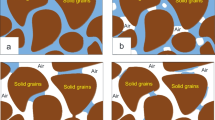An iteration computational algorithm is presented for optimization of the passive regime of artificial freezing of a water-saturated rock mass, which is the longest and most cost-intensive stage in the process of shaft excavation and carriage installation. The optimization is implemented by solving the inverse problem of determination of the heat flux on the boundary of a freezing well in a horizontal rock layer. Heat transfer in the rock layer is considered with account taken of the phase transition of the first kind on the basis of the Stefan problem in a two-dimensional formulation. The developed algorithm is based on the principle of descriptive regularization and the optimization method of steepest descent. In the algorithm, the target functional gradient and the parameters of optimization of the problem′s solution are determined from the solution of a conjugate problem for temperature increment. Using the proposed algorithm, optimum regimes of passive freezing for rock layers with different thermal and physical characteristics under varied initial conditions have been obtained.
Similar content being viewed by others
References
N. G. Trupak, Freezing of Grounds in Underground Development [in Russian], Nedra, Moscow (1974).
N. S. Ivanov, Heat and Mass Transfer in Frozen Rocks [in Russian], Nauka, Moscow (1969).
G. Gioda, L. Locatelli, and F. Gallavresi, A numerical and experimental study of the artifi cial freezing of sand, Can. Geotech. J., 31, No. 1, 1–11 (1994).
X. Tan, W. Chen, H. Tian, and J. Cao, Water flow and heat transport including ice/water phase change in porous media: numerical simulation and application, Cold Regions Sci. Technol., 68, Nos. 1–2, 74–84 (2011).
P. N. Vabishchevich, M. V. Vasilyeva, and N. V. Pavlova, Numerical simulation of thermal stabilization of fi lter soils, Math. Models Comput. Simul., 7, No. 2, 154–164 (2015).
I. Panteleev, A. Kostina, M. Zhelnin, A. Plekhov, and L. Levin, Intellectual monitoring of artificial ground freezing in the fluid-saturated rock mass, Procedia Struct. Integrity, 5, 492–499 (2017).
M. S. Zhelnin, O. A. Plekhov, M. A. Semin, and L. Yu. Levin, Numerical solution for an inverse problem about determination of volumetric heat capacity of rock mass during artificial freezing, PNRPU Mech. Bull., No. 4, 56–75 (2017).
L. Y. Levin, M. A. Semin, and A. V. Zaitsev, Solution of an inverse Stefan Problem in analyzing the freezing of groundwater in a rock mass, J. Eng. Phys. Thermophys., 91, No. 3, 611–618 (2018).
E. Pimentel, S. Papakonstantinou, and G. Anagnostou, Numerical interpretation of temperature distributions from three ground freezing applications in urban tunneling, Tunnel. Undergr. Space Technol., 28, No. 1, 57–69 (2012).
G. V. Anikin and K. A. Spasennikova, Computer simulation of a system for cooling the ground under an oil tank, Kriosfera Zemli, 16, No. 2, 60–64 (2012).
Ya. B. Gorelik, A. B. Shabarov, and Yu. S. Sysoev, Dynamics of thawing of frozen rocks in the zone of infl uence of two wells, Kriosfera Zemli, 12, No. 1, 59–65 (2008).
A. A. Samarskii and P. N. Vabishchevich, Computational Heat Transfer [in Russian], Librokom, Moscow (2009).
V. R. Voller, C. R. Swaminathan, and B. G. Thomas, Fixed grid techniques for phase change problems: A review, Int. J. Numer. Methods Eng., 30, No. 4, 875–898 (1990).
V. R. Voller, Enthalpy method for inverse Stefan problems, Numer. Heat Transf. Part B: Fundamentals, 21, No. 1, 41–55 (1992).
A. Khosravifard, M. R. Hematiyan, and L. C. Wrobel, Simultaneous control of solidus and liquidus lines in alloy solidification, Eng. Anal. Bound. Elem, 37, No. 2, 211–224 (2013).
G. Z. Yang and N. Zabaras, The adjoint method for an inverse design problem in the directional solidifi cation of binary alloys, J. Comput. Phys., 140, No. 2, 432–452 (1998).
E. Hetmaniok, J. Hristov, D. Słota, and A. Zielonka, Identifi cation of the heat transfer coeffi cient in the two-dimensional model of binary alloy solidifi cation, Heat Mass Transf., 53, No. 5, 1657–1666 (2017).
R. Tavakoli, Thermal optimization of the continuous casting process using distributed parameter identification approach — controlling the curvature of solid–liquid interface, Int. J. Adv. Manuf. Technol., 94, Nos. 1–4, 1101–1118 (2018).
S. A. Nekrasov and V. S. Volkov, Optimum control in the Stefan problem and methods of its computation, Vesti St. Petersburgsk. Univ., Ser. 10. Prikl. Mat. Inform. Protsessy Upravl., No. 2, 87–100 (2016).
A. F. Albu, V. I. Gorbunov, and V. I. Zubov, Optimal control of the process of melting, Comput. Math. Math. Phys., 40, No. 4, 491–504 (2000).
A. F. Albu and V. I. Zubov, Investigation of the optimal control problem for metal solidifi cation in a new formulation, Comput. Math. Math. Phys., 54, No. 5, 756–766 (2014).
N. L. Goldman, Inverse Stefan Problem, Kluwer Academic Publisher, Dordrecht (1997).
O. M. Alifanov, Inverse Heat Transfer Problems, Springer-Verlag, Berlin (1994).
H. Kano, H. Nakata, and C. F. Martin, Optimal curve fitting and smoothing using normalized uniform B-splines: A tool for studying complex systems, Appl. Math. Comput., 169, No. 1, 96–128 (2005).
Author information
Authors and Affiliations
Corresponding author
Additional information
Translated from Inzhenerno-Fizicheskii Zhurnal, Vol. 93, No. 3, pp. 706–714, May–June, 2020.
Rights and permissions
About this article
Cite this article
Zhelnin, M.S., Plekhov, O.A. & Levin, L.Y. Optimization of the Passive Regime of Artificial Freezing of a Water-Saturated Rock Mass. J Eng Phys Thermophy 93, 685–692 (2020). https://doi.org/10.1007/s10891-020-02167-8
Received:
Published:
Issue Date:
DOI: https://doi.org/10.1007/s10891-020-02167-8




